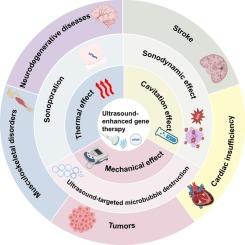Ultrasound-enhanced gene transfection: vectors, methods, and biomedical applications
IF 9.7
1区 化学
Q1 ACOUSTICS
引用次数: 0
Abstract
Gene therapy relying on the efficiency of gene delivery or transfection has become a widely applied approach in numerous biomedical fields. Ultrasound, featuring non-invasive and deep tissue penetration nature, offers effective enhancement treatment with precise targeting and minimal side effects. Here, we critically analyze the vectors, methods, and biomedical applications of ultrasound-enhanced gene transfection. Firstly, the therapeutic potential of ultrasound lies in its synergistic thermal, cavitation, and mechanical effects. Secondly, various vectors, both viral and non-viral, are available for delivering therapeutic genes. Additionally, techniques like sonoporation, sonodynamic effect, and ultrasound-targeted microbubble destruction enable the precise delivery of bioactive genes to targeted tissues. We particularly highlight the diverse biomedical applications of ultrasound-enhanced gene transfection across different disease areas, including cancer, cardiac insufficiency, stroke, neurodegenerative disease, and musculoskeletal disorders, demonstrating promising prospects for clinical application. Finally, we systematically address the current challenges and perspectives to inform the design of ultrasound-enhanced gene transfection compared to conventional gene therapies. This review aims to guide new developments in ultrasound-enhanced gene transfection and contribute to its widespread utilization in biomedical applications.

超声增强基因转染:载体、方法和生物医学应用
依赖于基因传递或转染效率的基因治疗已成为众多生物医学领域广泛应用的方法。超声,具有非侵入性和深层组织渗透性质,提供有效的增强治疗,精确的目标和最小的副作用。在这里,我们批判性地分析了载体、方法和超声增强基因转染的生物医学应用。首先,超声波的治疗潜力在于其协同的热、空化和机械效应。其次,各种载体,包括病毒和非病毒,可用于传递治疗基因。此外,诸如声穿孔、声动力效应和超声靶向微泡破坏等技术可以将生物活性基因精确地传递到目标组织。我们特别强调超声增强基因转染在不同疾病领域的不同生物医学应用,包括癌症、心功能不全、中风、神经退行性疾病和肌肉骨骼疾病,展示了临床应用的良好前景。最后,我们系统地讨论了当前的挑战和观点,以告知超声增强基因转染与传统基因治疗的设计。本文综述了超声增强基因转染技术的最新进展,以期促进其在生物医学领域的广泛应用。
本文章由计算机程序翻译,如有差异,请以英文原文为准。
求助全文
约1分钟内获得全文
求助全文
来源期刊

Ultrasonics Sonochemistry
化学-化学综合
CiteScore
15.80
自引率
11.90%
发文量
361
审稿时长
59 days
期刊介绍:
Ultrasonics Sonochemistry stands as a premier international journal dedicated to the publication of high-quality research articles primarily focusing on chemical reactions and reactors induced by ultrasonic waves, known as sonochemistry. Beyond chemical reactions, the journal also welcomes contributions related to cavitation-induced events and processing, including sonoluminescence, and the transformation of materials on chemical, physical, and biological levels.
Since its inception in 1994, Ultrasonics Sonochemistry has consistently maintained a top ranking in the "Acoustics" category, reflecting its esteemed reputation in the field. The journal publishes exceptional papers covering various areas of ultrasonics and sonochemistry. Its contributions are highly regarded by both academia and industry stakeholders, demonstrating its relevance and impact in advancing research and innovation.
 求助内容:
求助内容: 应助结果提醒方式:
应助结果提醒方式:


